

With the Edge Explore, less is more
Even more functions? Even more expensive? No thanks. Garmin proves that less can be more with the "Edge Explore". The bike computer dispenses with a few tools for professionals, but is affordable and attractive for touring cyclists.
My last Garmin was a "Dakota 20", built in 2009. Then the smartphone era began and made it superfluous for me at some point. I switch the veteran on again and immediately remember why: tiny icons, a barely usable touchscreen, dark display. Disaster. At some point, the smartphone was enough for me and set the standard in terms of user-friendliness. While the Garmin bike computers evolved into high-tech power meters with sat nav functions, I didn't miss anything on bike tours and the occasional mountain bike ride.
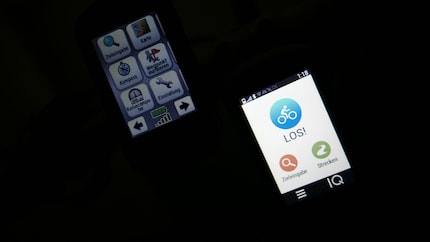
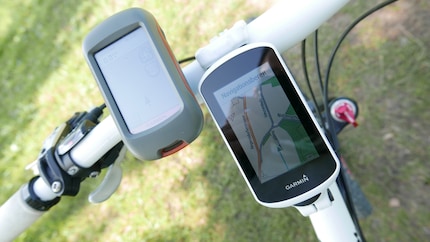
With the "Edge Explore" from Garmin, there is now another device that I am giving a chance. Why? Because it does away with some of the functions for cracks, but comes with a more attractive price tag. If you don't care about things like training plans, Strava Live segments or power meter support for biking like I do, you should take a closer look at it. The Edge Explore can also do more than enough for normal riders like me. I think most users can still do without most of the functions on this device. The main thing is that the navigation is good.

First impression and installation
The Edge Explore looks like the little brother of the Edge 1030, which is equipped with all the bells and whistles and can do much more than I would ever need. I find the compact dimensions of the Explore advantageous; the three-inch colour display with its resolution of 240 x 400 pixels is enough for me. The device sits comfortably in the hand and can be quickly attached anywhere with the rubber ring mount. On the handlebars or stem, whatever suits you and your bike. I alternated between mountain bikes and everyday bikes during the course of my testing and always placed the Garmin on the stem.
The device also has three buttons on the sides: one to lock or activate the display, one to start/stop recording and one to start a new (training) lap. With a built-in 1150 mAh battery that is supposed to last up to twelve hours, the Edge Explore weighs 116 grams. When I connect it to the PC for the first time and connect it to Garmin Express, it immediately downloads a software update. I could now also update the European maps pre-installed on the 16 GB internal memory. As the update takes 2 hours and 43 minutes, I decide against it for the time being. I want to get going. Fill some of the free 7.7 GB with tour data.
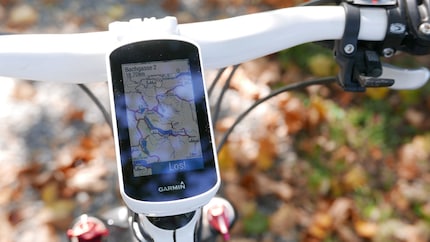
The navigation
It is probably the main interest of anyone who is interested in the Edge Explore. Once you have switched on the device and made the usual basic settings, you can get started after just a few seconds and select addresses, coordinates or POIs using the destination input. This is how I start my Explore exploration. I get on, enter destinations and see how well it works for me. I quickly realise that it at least makes sense to define the routing mode in the menu under "Tour settings": Road bike? Mountain bike? Off-road? Cycling on different surfaces? On foot? Could still make a difference.
After it took a while to find the position and start the route guidance the first time I used it, navigation via GPS is now always fast and reliable. When navigating, it's important to me that the recalculation is quick and that the device doesn't hold on to its route forever if I decide to take a different route. This works well with the Garmin. It quickly has the next instruction ready if I ignore one and never asks me to turn back. In return, I can overlook the fact that the original route suggestions are not always congruent with my ideas and that the instruction sounds are reminiscent of an undead Tamagotchi from the 90s.
If you want to tackle longer tours and plan a route with lots of waypoints, it's better to do this via the Connect app or preferably on your computer. Planning with multiple waypoints on the Explore itself is otherwise a bit fiddly and tedious. However, if you want to go for a spontaneous ride, the Edge Explore can also suggest circular routes of the desired length for your current position at any time.
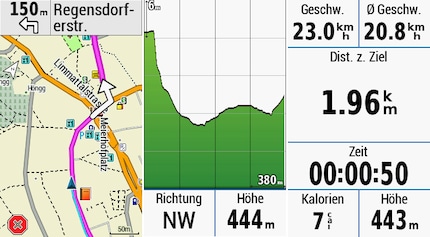
Operation and menu navigation
The Edge Explore is really easy to use. The display responds very well, can also be operated with gloves and the basic functions are quickly accessible. The lack of an ambient light sensor is a particular pity. You therefore have to set the display brightness manually. As with Android mobiles, this is done via a menu that you can drag from the top of the display. As it was usually quite sunny during my test weeks, I set it to almost 100 per cent and then didn't change it. It was easy to read at all times and the topic was closed for me. Even if it is at the expense of battery life: who wants to constantly adjust it? What I would have liked to have customised is the button assignment. The "lap" function in particular is not very useful on tours, but unfortunately cannot be changed. During the ride, you can easily swipe back and forth between the three main views, which show you the map, elevation profile and data such as speed, distance to destination or calories burned. You can freely configure which of these you want to see here. That's possible.
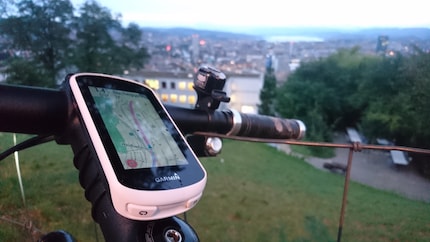
Connectivity
The Garmin Edge Explore is not just a navigation device, but also a small command centre. If you connect your smartphone via Bluetooth, you can analyse your tours directly in the Connect app or start GroupTrack sessions with friends. You can also be notified of incoming calls and text messages on the Explore and activate the automatic accident notification function. For me, the connection to my mobile was always established straight away as soon as I switched on the Garmin.
Other sensors can also be paired via ANT+. I tried it out with the Varia RTL510 and was really impressed by this radar rear light. Not only does it shine brightly behind me, it also reliably detects what is going on behind me on the road. If a vehicle is approaching, this is signalled by a warning tone and visually on the edge of the display. If the Bluetooth and ANT+ options are not enough for you, you can find what you are looking for in Garmin's Connect IQ Store and expand the functionalities of the Edge Explore with apps and widgets.
Conclusion
I've done well with the Garmin. The quality of the hardware and software is right and the only thing that has been saved is functions that I don't miss (apart from the ambient light sensor). The Edge Explore does not have sophisticated training functions, a barometric altimeter or an electronic compass. It also "only" relies on GPS. Accordingly, the recorded data is not beyond reproach. If absolute accuracy is important to you, you will probably have to dig deeper into your pocket.
However, if you are looking for a good and handy turn-by-turn sat nav that will accompany you on your bike rides or hikes and doesn't cost a fortune, there is a lot to be said in favour of the Edge Explore. You'll be up and running quickly and still have plenty of additional functions to discover. I tried out a few things step by step and configured the device more and more to suit my preferences. There was never any frustration and I never experienced any crashes. It's hard to say how long the battery will last in the end, but a day trip should definitely be possible. However, it is a shame that it is permanently installed and cannot be easily replaced. Otherwise, the Edge Explore has what it takes to be a reliable touring companion for several years to come.
Simple writer and dad of two who likes to be on the move, wading through everyday family life. Juggling several balls, I'll occasionally drop one. It could be a ball, or a remark. Or both.